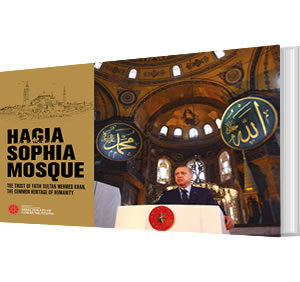The Conquest of Istanbul
Fatih’s Hagia Sophia Foundation Charter:
Hagia Sophia Al-Kabeer Mosque (The Great Hagia Sophia Mosque)
The conquest of Istanbul has been a landmark not only in Turkish and Islamic history but in the history of all humanity. The Ottoman Empire made peace, tolerance, and prosperity prevail for centuries in a wide area. This period called “Ottoman Peace” (Pax Ottomana) in the history is a reflection of an unprecedented peace climate and an envisagement of civilization in the challenging geographies such as the Middle East, North Africa, the Balkans and the Caucasus, now known for the relentless conflicts and wars therein. The sense of leniency, ensuring that people from different nations, tribes, languages, religions, sects, and dispositions lived together in peace and tranquility for centuries, manifested itself in Fatih Sultan Mehmed Khan’s attitudes since the first minutes of the conquest of Istanbul.
Upon conquering Istanbul, Fatih Sultan Mehmed Khan ordered not to harm anyone in the city, put an end to the arrest of civilians, banned the abuse of women and children, and the sale of people as slaves.
An age-long tradition in the Ottoman is to recite adhan in the greatest temple of a conquered city and to perform the first Friday prayer in this temple. Thus, it is a means to declare that the city was conquered, the temple in question is called the “Fethiye Mosque” (the Mosque of the Conquest) and the other temples in the city are not intervened unless necessary. Fatih Sultan Mehmed Khan, as a symbol of the conquest, hoisted his flag at the mihrab in the middle of the Hagia Sophia, shot an arrow towards the dome, and recited the first adhan. Thus, he registered his conquest. Then, by going down for prostration of gratitude, he performed two rak'ahs of prayer. With this act, he demonstrated that he converted the Hagia Sophia into a mosque.
On the third day of the conquest, the first Friday prayer led by the spiritual architect of the conquest Akshamsaddin as the imam was performed in the Hagia Sophia Mosque. Fatih Sultan Mehmed Khan delivered a khutbah to his army during this first Friday prayer.
Since it had been deprived of a good administration for a long time and thus condemned to poverty and destruction, immediately after the conquest of Istanbul, Fatih Sultan Mehmed Khan exerted great efforts to quickly reconstruct Istanbul, and the works it hosted, especially Hagia Sophia. These reconstructing works were carried out through foundations having prominent importance in the social structure of the Turkish-Islamic Civilization. In this context, with the conquest of Istanbul, Fatih Sultan Mehmed Khan, who received the title of Roman Emperor and possessed all the properties registered on the Byzantine dynasty, endowed the mosque with the first prayer performed in Hagia Sophia, and created the “Fatih Complex and the Hagia Sophia Al-Kabeer Foundation”. In his will, Fatih Sultan Mehmed Khan prescribed the preservation of Hagia Sophia eternally and stipulated the maintaining of its mosque status.
Foundations were established to provide all social services of Istanbul. Thus, Istanbul became one of the most successful centers where the foundation culture, regarded as a flawless system in fields such as science, education, arts, and social aid, were implemented. Istanbul took a form representing the concept of high urban planning of the Turkish-Islamic Civilization.
Foundations were established with a 'foundation charter’ registered by the judicial authority. Foundation charters contain binding provisions for everyone, including the sultan. The foundation charter dated 1462, which determined the legal status of the Fatih Complex and the Hagia Sophia Al-Kabeer Foundation, is considered one of the most important documents in this regard.
Sultan Fatih'in Ayasofya Vakfiyesi Tercümesinden Bir Bölüm
This foundation charter is registered at the Turkish and Islamic Art Museum with the number 2202 (formerly 666). The copy registration of this foundation charter made during the period of Evkaf Nezareti (Ministry of Foundations), is recorded with the number 46 in the Foundation Book no. 6 of Istanbul in the Archive of the General Directorate of Foundations. The modern Turkish version of the same foundation charter translated in the period of the Republic of Turkey is registered with item number 46 from page 82 onward in the book number 575 in the Archive of the General Directorate of Foundations. In this document, subjects such as charities, terms of charity, properties, management of the foundation are explained in detail, and "foundation prayer" and a "foundation curse" are also included as in every foundation charter.
When Fatih Sultan Mehmed Khan's Hagia Sophia foundation charter is examined, it is found that this foundation was one of the most significant institutional structures of that time especially in terms of education, religion, and health services. Furthermore, numerous markets, bazaars, shops, and houses have been granted to the foundation as property to ensure the continuity of these services.













